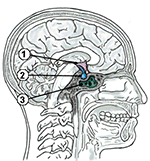 The Greater Occipital Nerve influences the fluid output of the lining of the sphenoid sinus (see suboccipital pages.) Pressure or irritation on this nerve can cause histamine to be released in the sphenoid sinus (3). Histamine irritates the sphenoid lining, causing it to overproduce fluid. The membranes around the sinus opening then swell shut in an attempt to absorb this fluid. Pressure builds up inside the sinus, and the sphenoid sinus become blocked, so that air can no longer circulate and carry away body heat. The hypothalamus (1) and pituitary (2) glands warm to full body temperature and may begin to dysfunction. The Greater Occipital Nerve influences the fluid output of the lining of the sphenoid sinus (see suboccipital pages.) Pressure or irritation on this nerve can cause histamine to be released in the sphenoid sinus (3). Histamine irritates the sphenoid lining, causing it to overproduce fluid. The membranes around the sinus opening then swell shut in an attempt to absorb this fluid. Pressure builds up inside the sinus, and the sphenoid sinus become blocked, so that air can no longer circulate and carry away body heat. The hypothalamus (1) and pituitary (2) glands warm to full body temperature and may begin to dysfunction.
The swollen sinus can also press against bone that in turn presses against these two important glands. One way or another, they begin to lose their ability to effectively regulate the complex body chemistry. Many kinds of inflammations, from cold symptoms to herpes outbreaks, can also be tied in to excess histamine release caused by an irritated or stopped-up sinus.
PULSING all of the suboccipital muscles, especially Rectus Capitis Posterior Major (18) (see suboccipital page), will help to relieve the irritation to the sphenoid sinus, and help with all associated complaints.
|

